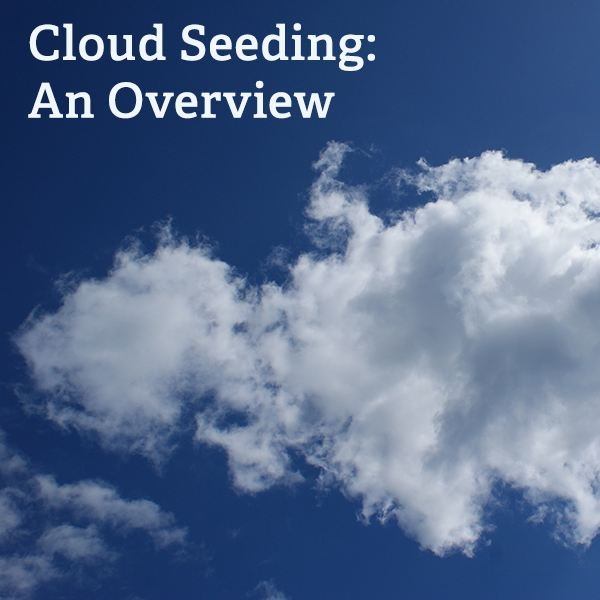Cloud Seeding: Understanding Its Meaning and History
A Long-Cherished Dream
Have you ever looked at a cloudy sky at some stage and been convinced that a downpour is imminent only to be proved wrong by the weather? Controlling the weather is one of man’s oldest dreams and down through the millennia it has proved to be elusive.
However, in the last century, man has had some success in persuading nature to oblige with rain on demand. We discuss the history of cloud seeding and explain how the technique can be used to induce rain.
The Origin of Cloud Seeding
While the dream of influencing the weather in some way is probably almost as old as mankind, the history of cloud seeding is relatively short. The origins of cloud seeding can be traced back to 1946 and was developed from an unrelated experiment by scientists at General Electric laboratories in Schenectady, New York. The General Electric scientists discovered that slivers of dry ice (solid carbon dioxide) could cause ice crystal formation in super-cooled water. Super-cooled water refers to the presence of liquid water at temperatures below its normal freezing point and it is to be found in certain clouds. The discovery spawned a series of laboratory based experiments, which were followed by atmospheric trials. The first operational cloud seeding programs commenced about four years after the initial discovery.
Of Clouds and Rain
Cloud is made up of water vapor and precipitation will occur when ice crystals form within them, if the temperature is low enough; or through the coalescence of smaller water droplets in warmer systems. As the ice crystals or water droplets gain mass, they develop enough weight such that they can no longer be supported on the air column and will fall as precipitation (this term covers both liquid and solid forms of water). Depending on the temperature of the air through which it falls, frozen precipitation may melt to form rain before it reaches the ground or can fall as hail or snow.
The critical process in precipitation is that of growth of the water (or ice) droplets to such a point that they can no longer be suspended. The growth of these droplets is dependent on a process called nucleation where a “seed” triggers the growing process. The seed can be an ice crystal or a speck of dust, but it can also be a man-made nucleation process which is the case in cloud seeding. In a cloud containing super-cooled liquid, the cloud itself must be below freezing; super-cooled liquid then coalesces onto ice crystals, freezing in the process and increasing the mass of the agglomerate.
Seeding Clouds
Cloud seeding can be achieved from the ground or from the air depending on the height of the target cloud. The process of nucleation within the target cloud is not instantaneous, consequently, specific portions of the cloud may be targeted to ensure that the seeding agent has time to work and the precipitation will fall where it is wanted.
There are two groups of agents used for cloud seeding purposes, and their use depends on the type of cloud being seeded. The first type is used when seeding cold cloud systems and includes so-called glaciogenic (ice-forming) compounds and includes silver iodide, dry ice and compressed gasses (compressed liquid propane or carbon dioxide). The second group is used for warmer clouds where the precipitation process depends on coalescence involves hygroscopic compounds (these attract moisture) such as salt, ammonium nitrate and urea.
The most common agent used for cloud seeding is silver iodide. The resulting concentration of silver iodide in the rainwater is approximately 0.1 ppb, or 500 times lower than the WHO guidelines for heavy metal concentration in drinking water.
Efficacy of the Technique
As we have seen from the history of cloud seeding, the technique was developed by serendipity; however, that does not mean that it is not valuable. Cloud seeding technology finds use in many countries and for a range of purposes. Commonly, the technique is used to boost rainfall and appeals to a range of clients such as operators of hydroelectric plants, farmers and ski resorts. The mechanism is even used (in the form of glacinogenic operations) by airport authorities as a mechanism to disperse fog by causing the water droplets to coalesce as rain. The majority of cloud seeding operations are conducted by a relatively small number of specialist companies.
Statistical studies have shown that cloud seeding is effective at increasing the rainfall in a target area. Depending on the circumstances, the technique may produce between a 5 and 20 percent increase for winter precipitation in continental (i.e. inland) areas and between a 5 and 30 percent increase in coastal regions. In warm seasons, the technique can trigger single-cloud increase of up to 100 percent. When the method of cloud seeding is used to suppress hail, the effectiveness is typically between 20 and 50 percent reduction.
References
- North American Weather Consultants Inc.: https://www.nawcinc.com/wmfaq.html
- Weather Enhancement Technologies International: https://www.wet-intl.com/
